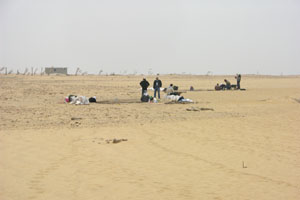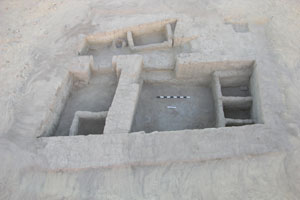|
At al-Qarah al-Hamra, on the north-eastern edge
of Lake Qarun in the Fayum depression (about
100 km. south-west of Cairo), are the remains of an previously unknown
Greaco-Roman settlement: |
|
As in antiquity the area is again under development
for agriculture and parts of the town have disappeared under olive groves.
The preserved parts, however, show good conservation:
|
|
|
|
|

|
|

|
|
|
|
|
|
|
|
|
Objective of visit:
|
|
To participate in a field school
explaining modern archaeological techniques to selected inspectors of
the Egyptian Supreme Council of Antiquities. |
|
Date of visit:
|
|
November/December 2004 |
|
Fellow visitors:
|
|
A team of inspectors of the
Egyptian Supreme Council of Antiquities and scholars from Egypt and abroad,
directed by Dr. Willeke Wendrich (UCLA, USA) and Dr. René Cappers
(University of Groningen, the Netherlands). |
| Results: |
|
A permanent 50 x 50 metre site
grid (marked by with metal stakes and aluminum labels) and a plan of the
artifacts scattered on the surface. |
| Approximate position and date of the site: |
|
al-Qarah al-Hamra is located
at the eastern end of the Fayum depression, between Karanis and Qasr al-Sagha,
at the edge of an area currently under development for agriculture. Surface
pottery seems mostly from the period of the Roman occupation of Egypt. |
| Short description of the site: |
|
The remains of the ancient
town are located in the desert just beyond an area again under development
for agriculture, between a new olive grove and a desert track leading to
the northern edge of Lake Qarun. They mostly exist of a large scatter of
artifacts (mainly broken pottery and corroded bronze) on the surface, but
a geophysical survey and two 5 x 5 m. trenches have shown relatively well
preserved ancient structures (mud-brick walls and kilns or ovens) just below
the wind-blown sand. |
| Additional remarks: |
|
My participation in this project
would not have been possible without the support of the Supreme Council
of Antiquities, the Cotsen
Institute of Archaeology and many individuals. |
| HOME |
|
|

|
|
|

